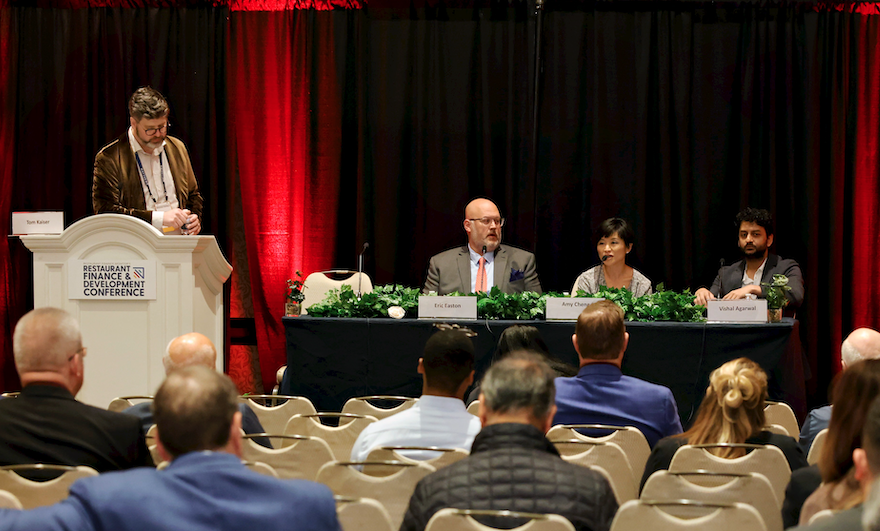Click here to view the full session
Negotiating delivery contracts is especially complicated for chains and franchised restaurant groups. The process, coupled with the accounting and reconciliation side of the business, remains onerous amid additional ordering channels coming online.
During the final day of the Restaurant Finance and Development Conference, Tom Kaiser, lead editor of Food On Demand, moderated a session asking panelists about the best practices to address these challenges.
Kicking off the conversation, Amy Cheng of law firm Cheng Cohen said the first thing for operators to understand when looking at negotiation is whether you are company-owned, have franchise units or both, “because that really dictates how you will go about negotiating the contract.”
“Years ago, when everyone started using third-party delivery, they barely had a contract to provide, and often we got the wrong form of contract,” said Cheng—adding that as the third-party delivery industry has grown to such a large part of the restaurant business, this is not as common of an occurrence.

Amy Cheng, Partner, at law firm Cheng Cohen and Vishal Agarwal, CEO of ItsaCheckmate
Noting that restaurants have seemingly moved beyond discussing exclusivity, Cheng relayed that, aside from commissions and fees, another big topic of discussion with clients today is reconciliation.
“I think one thing we can all agree on at this point, is that whether you’re the franchisor or the franchisee, you’re not really going to have control over the refund. It’s the 3PDs who ultimately are going to have that decision,” said Cheng. “I feel like the 3PDs have so much control over that, and there are certain terms, at least information, you can get from them [3PDs] to figure out how better to avoid having a refund.”
Eric Easton, CFO of Ampex Brands, a franchisee group with big names under its umbrella such as Pizza Hut, KFC, Taco Bell and other Yum brands, posed common questions that arise when it comes to reconciliation.
“Did my DoorDash driver pick up my food and deliver it accurately and did I get paid for that?” he asked.
Easton brings up moments where consumers report fraudulent refunds in hopes of getting free or discounted items. “Did my customer complain and say they didn’t receive a Diet Coke but really it was there?” he asked. “If you’re a big enough operator you get fraudulent charges every day.”
“So how do you figure out how to get the cash that should be in your bank account” and “fight a player like DoorDash or Uber Eats, that has a lot of power in the marketplace?” asked Easton.

Eric Easton, CFO Ampex Brands
Easton noted that with Ampex having such large brands, the company has the bandwidth to manage such transactions, but the average small operator, “doesn’t have the same pool to get that done.”
ItsaCheckmate is one company offering solutions to both SMB and large chains to better manage refunds and chargebacks. The platform, which offers POS integration and digital menu management has honed in on its reconciliation features over the past three years.
Vishal Agarwal, ItsaCheckmate founder and CEO, said it all started when he visited restaurant offices and “saw accountants downloading reports from all these third parties, trying to reconcile them.”
“My delivery platforms told me that last week I did $3,600 in revenue…but my bank account is showing me $2,300, help me make sense of this,” Agarwal said in discussing examples of discrepancies he’s heard from operators.
Agarwal’s team then set out to create a platform that automatically provides a unified view of disparate third-party financial statements, providing transaction-level details from all orders to eliminate manual data extraction.
“We are combining all of the information we’re getting and giving them a really clear breakdown, right to the journal entry level,” he said.
“I think overall operational efficiency of third-party delivery in specific and digital ordering in general, is going to come down to making sure that this becomes a core part of a restaurant’s operations. You can’t just write off what doesn’t reconcile anymore,” said Agarwal.
Agarwal also said that managing disputes can be aided with education at an operational level. “If a restaurant keeps forgetting to put sides into the delivery bag, somebody needs to fix that,” he added.
More on negotiation, Cheng said restaurant size does play a role and the smaller you are the harder the process will be.
“There’s difference in marketing power, what contributions are they going to make to marketing, for example…but there are certain terms that I think they will consider no matter the size,” she said.
Price parity also bubbled up as a hot topic during the discussion.
Easton said, “I think it’s less about the commission than it is actually about how much you can raise your prices to cover the commission.”
“Even with Yum [Brands], one of the largest on the planet, you’re still capped in how much you can raise versus your fees…but the reality is, if you get charged 20 percent [in fees] but you can only raise 18 percent [menu price], you’re still missing out,” said Easton.
“The 3PDs want to make sure you are not selling on their website a price higher than others [channels],” said Cheng. “Are they asking for price parity with respect to dine-in?” she asked—adding that is very difficult to accomplish.
“But people are willing to pay more for the convenience of delivery,” she said, “So trying to avoid a price parity commitment is key as well.”


